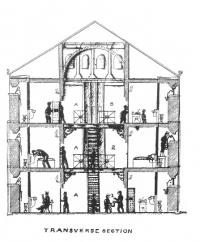Irish Prison Registers and Landed Estate Court Rentals now available on-line
Published in 18th-19th Century Social Perspectives, 18th–19th - Century History, 20th Century Social Perspectives, 20th-century / Contemporary History, General, Issue 6 (Nov/Dec 2011), News, Volume 19
Transverse section of Dublin’s Mountjoy prison’s ‘A’ wing—one of several drawings confiscated from prisoner William MacDonagh in the 1860s. (National Archives of Ireland)
The Irish Prison Registers 1790–1924, held at the National Archives of Ireland, are one of the greatest untapped resources for tracing Irish ancestors. They contain over 130,000 pages which include nearly three million records of imprisonment providing a wealth of information on each prisoner, including name, address, place of birth, occupation, religion, education, age, physical description, name and address of next of kin, crime committed, sentence, dates of committal and release/decease. These records have recently been digitised and indexed by findmypast.ie and are now available on the Irish family history site. The index includes all personal names and addresses recorded in these entries, which amount to over four million names, of which many are the names of victims. The prison records relate to all types of custodial institutions, from bridewells to county prisons to alcoholic sanatoriums.With Ireland at one stage holding the title of ‘the most incarcerated nation in Europe’, it comes as no surprise that the reasons for incarceration cover the whole spectrum of crime from theft to murder, as well as political reasons, such as involvement in rebellion. The most common reason for imprisonment was drunk and disorderly behaviour, followed by theft, assault and trespass. Other common crimes included a significant number ‘absconding from the poor house’ and other workhouse offences, begging, vagrancy, prostitution and riot. The registers offer a real insight into Irish society and the stories contained touch on the major themes of Irish family history, from poverty and destitution to rebellion and social confrontation. Almost every Irish family was touched by these records—as offenders, their relatives or victims.The release of the records represents the fruition of another major agreement between the newest player in the Irish family history business, findmypast.ie, and the National Archives of Ireland. These agreements are mutually beneficial, with findmypast Ireland providing the expertise and manpower to digitise and index these important records in exchange for five years of exclusive access, after which time the National Archives can provide free access to the data.The first of these agreements was struck on the Landed Estate Court Rentals, now one of findmypast.ie’s flagship record sets, which were widely recognised as another underappreciated resource for Irish family history research. The relationship began in 2009, when Brian Donovan and Fiona Fitzsimons of Eneclann made it their objective to digitise these records. They approached brightsolid online publishing, the Scottish-based experts in the digitisation of precious records, who own and/or operate a family of sites including findmypast.co.uk, ScotlandsPeople.gov.uk as well as the Friends Reunited Group. From this a joint venture was formed, findmypast.ie was born and the digitisation and indexing of the Landed Estate Court Rentals began.The rentals are effectively printed sale catalogues, which were circulated to prospective purchasers in advance of the sale. They were compiled with the intention of attracting purchasers and of providing information on the estate in a clear and uniform manner. The land courts sold estates in every county in Ireland, and the rentals as a whole cover large parts of the country. The estates sold included urban as well as rural property and many of the rentals relate to houses and other buildings in villages, towns and cities.The title page in a rental identifies the estate and gives the date and place of sale. This is usually followed by brief descriptive particulars of the estate and its situation, intended to attract prospective buyers. Anyone who has read the property section of a newspaper will know what to expect in this section. To the family historian, the critical information contained in these catalogues is included in the lot descriptions. The details often include:
Names of tenants: the particulars will also name all lives contracted for (usually three) and any of those names still alive at the time of the sale.Map reference: the rentals usually include a map to situate the estate or lot in relation to the surrounding countryside, and often also a detailed map of the lot itself. In the case of urban property you will find a village or town plan.Yearly rent in pounds, shillings and pence.Day rent is due: labelled as ‘Gale days’.Size of plot in acres, roods and perches.Length of tenure.Observations: this column, which lays out the terms by which the land is rented, often includes interesting insights into the plots of land and those who rented them. It was typical for a lease to be given for 21 years or three lives (named). The date of the original lease is often given, along with any circumstances of note regarding the tenant or plot.
The information contained in the on-line edition of the Landed Estate Court Rentals and the Irish Prison Registers is a testament to the progress of Irish family history research over the last decade. Previously, the amateur family historian would have been content to find out merely names and dates associated with their ancestors, but the difficulties with even that in Ireland have led genealogists to think outside the box and look for more interesting windows on our past. These two new record sets are a perfect example of this as they provide not only names and dates but also key facts about our ancestors’ lives, such as where exactly they lived, who they lived with, what they looked like and how educated they were. HIWebsite: www.findmypast.ie
















